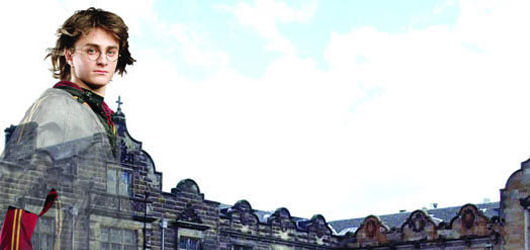Light speed hurdle to invisibility cloak overcome by student

Image © The Scotsman. Used with permission.
An undergraduate student from the University of St Andrews has overcome a major hurdle in the development of invisibility cloaks.
Under the guidance of leading St Andrews’ invisibility expert Professor Ulf Leonhardt, Janos Perczel has designed an ‘invisible sphere’ that could allow an invisibility cloak wearer to move around amongst ever-changing backgrounds.
The key development lies in the ability of the sphere – an optical device – to not only remain invisible itself, but to slow down light. Previously light rays have been accelerated around cloaked objects at great speeds, limiting invisibility cloaks to only work in a specified region of the visible spectrum.
This new research, published today in the Institute of Physics and German Physical Society’s New Journal of Physics, now opens up the possibility for a camouflage-like invisibility cloak that works against the backdrop of a variety of colours.
During his research, Hungarian-born Janos (22) recognised the huge potential of the invisible sphere and was able to fine-tune it so that it was a suitable background for cloaking.
He developed this idea, first suggested by Professors Leonhardt and Tyc, when he was Professor Leonhardt’s summer student, funded by an EPSRC grant. For eight months, he worked on how to overcome the technical barriers to make the proposal practicable.
The usual approach to designing an invisibility cloak works on the basis of bending light around an object you wish to conceal, thereby preventing the light from hitting the object and revealing its presence in the eye of the observer.
Janos explained, “When the light is bent, it engulfs the object, much like water covering a rock sitting in a river bed, and carries on its path making it seem as if nothing is there.
“Light however can only be sped up, to a speed faster than it would travel in space, under certain conditions and this restricts invisibility cloaks to work in a limited part of the spectrum – essentially just one colour.
“This would be ideal if somebody was planning to stand still in camouflage; however the moment they start to move the scenery would begin to distort, revealing the person under the cloak.
“By slowing all of the light down with an invisible sphere, it does not need to be accelerated to such high speeds and can therefore work in all parts of the spectrum.”
An Institute of Physics spokesperson said, “This new development opens up further possibilities for the design of a practical invisibility cloak – overcoming the problem of light speed which other advances have struggled to address and, very impressively, this significant advance was achieved by an undergraduate student.”
ENDS
Notes to Editors
Janos is available for interview (in Hungary) on 0036 1 395 32 37, mobile 0036 30 385 86 68 or email [email protected]
Professor Leonhardt is available in St Andrews on 01334 463115, 0777 070 1348 or email [email protected]
Category Public interest stories